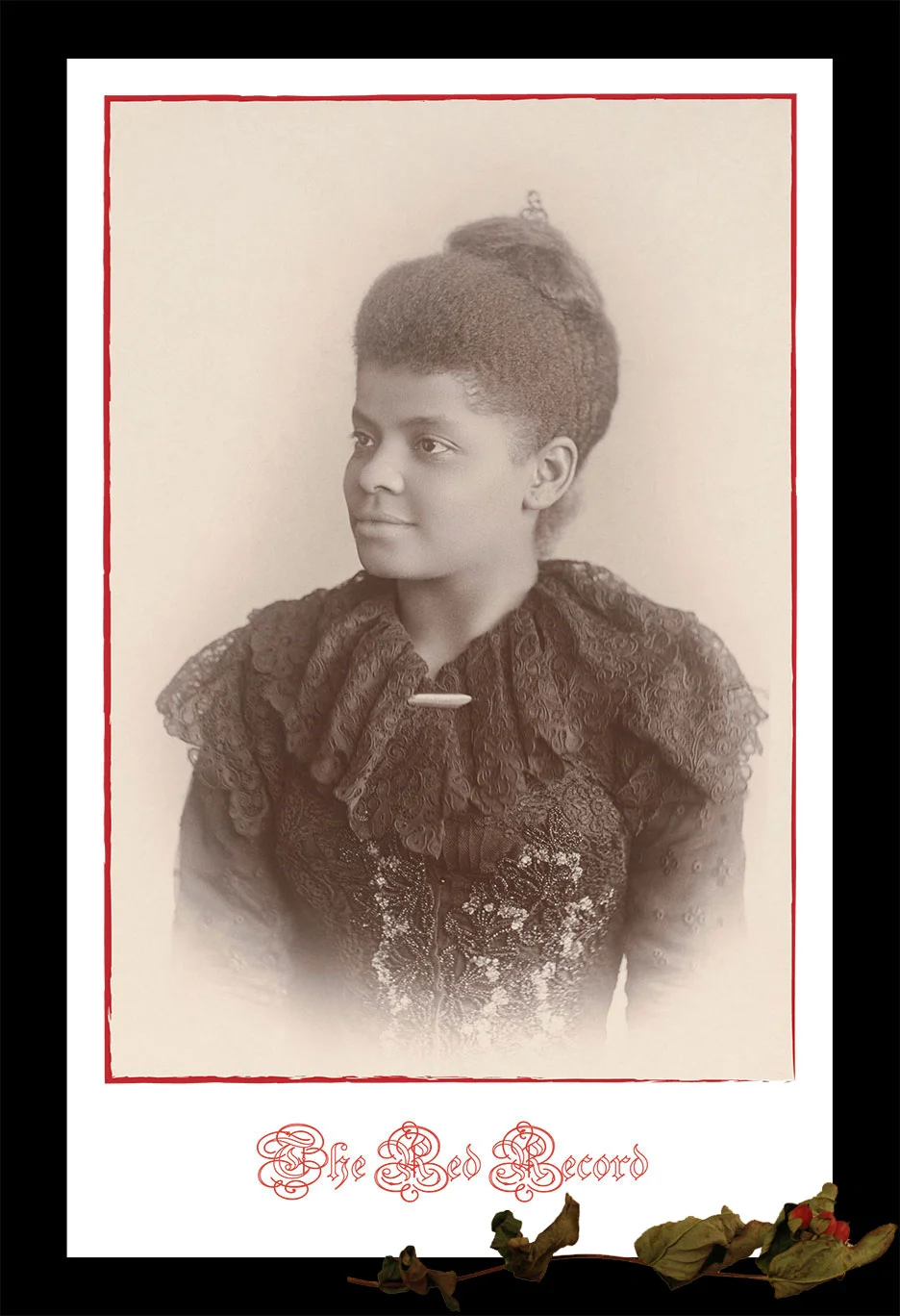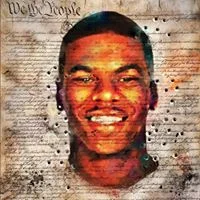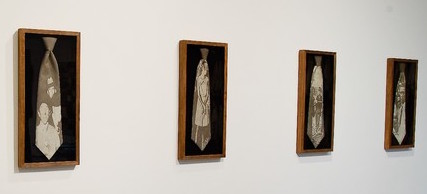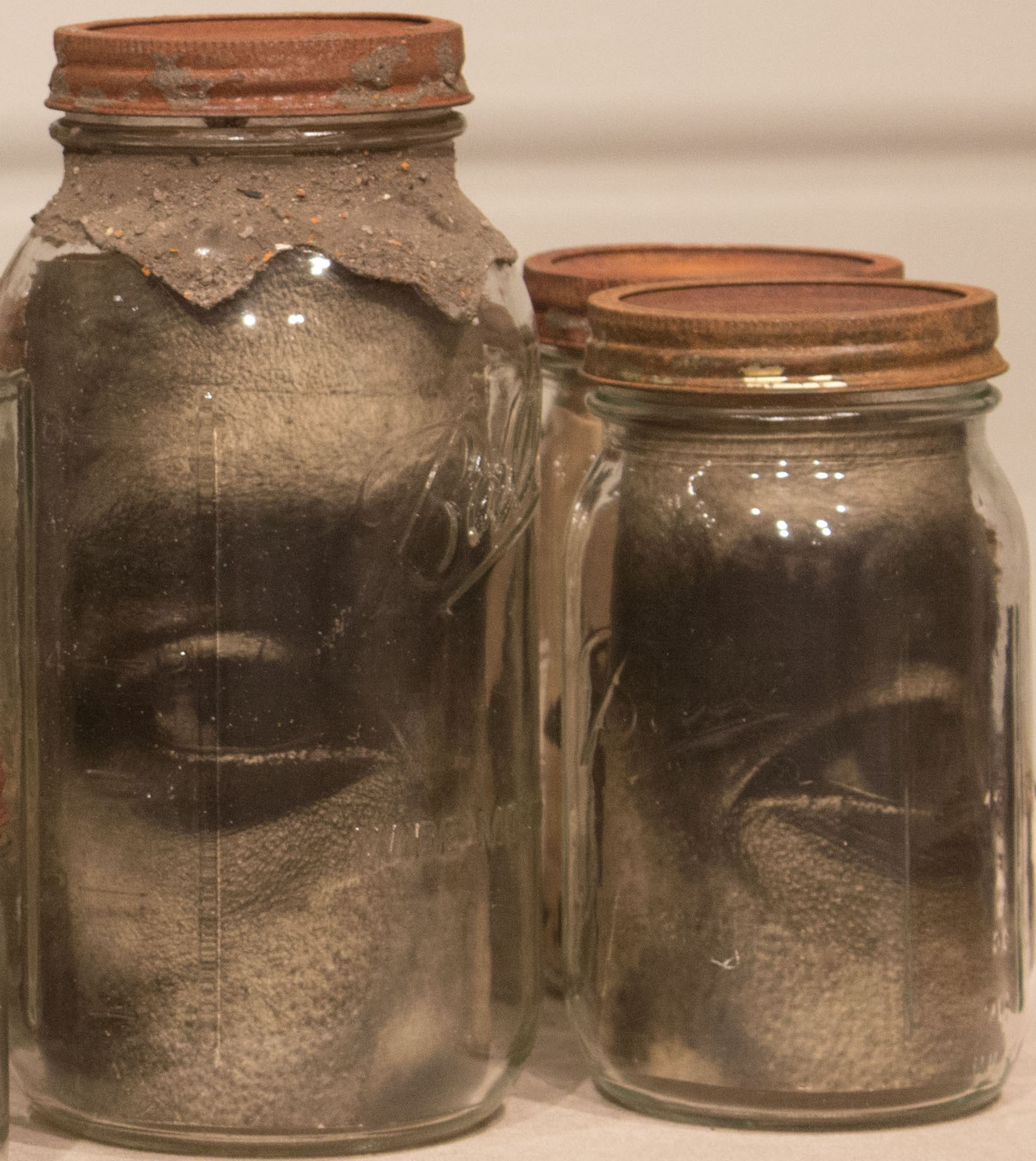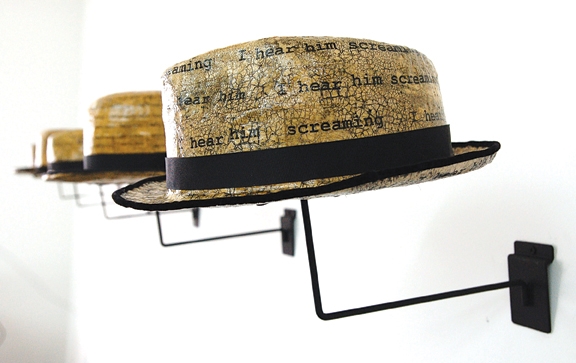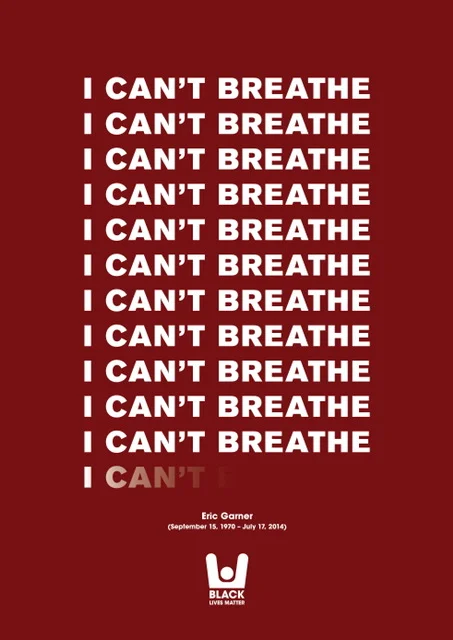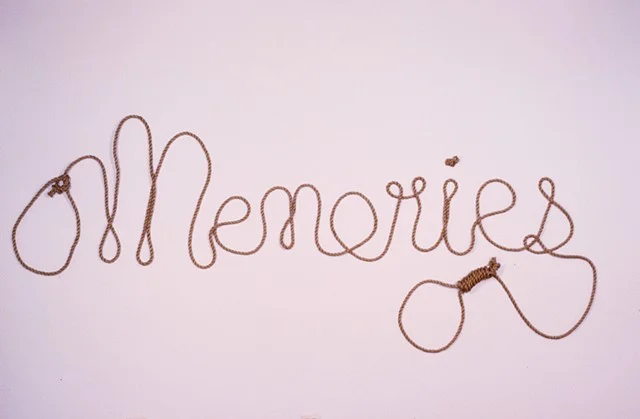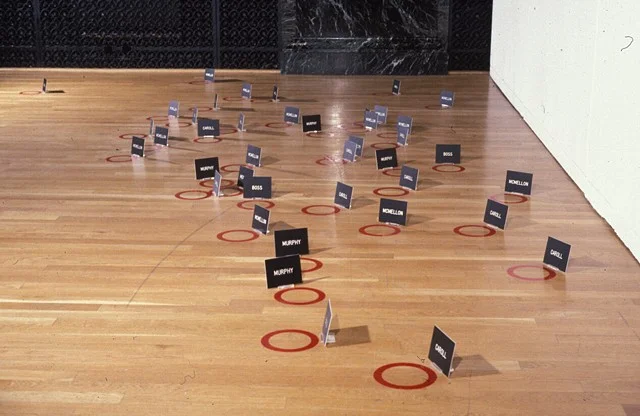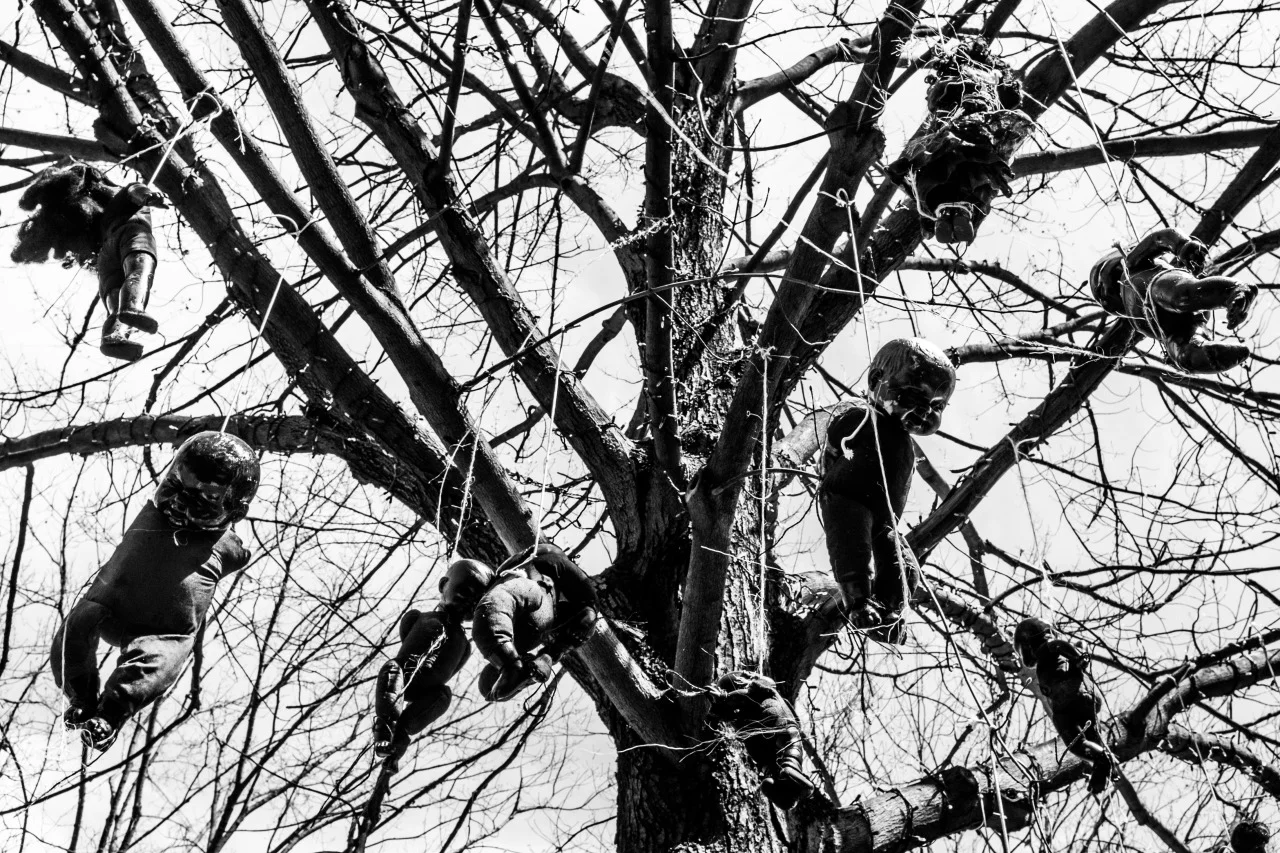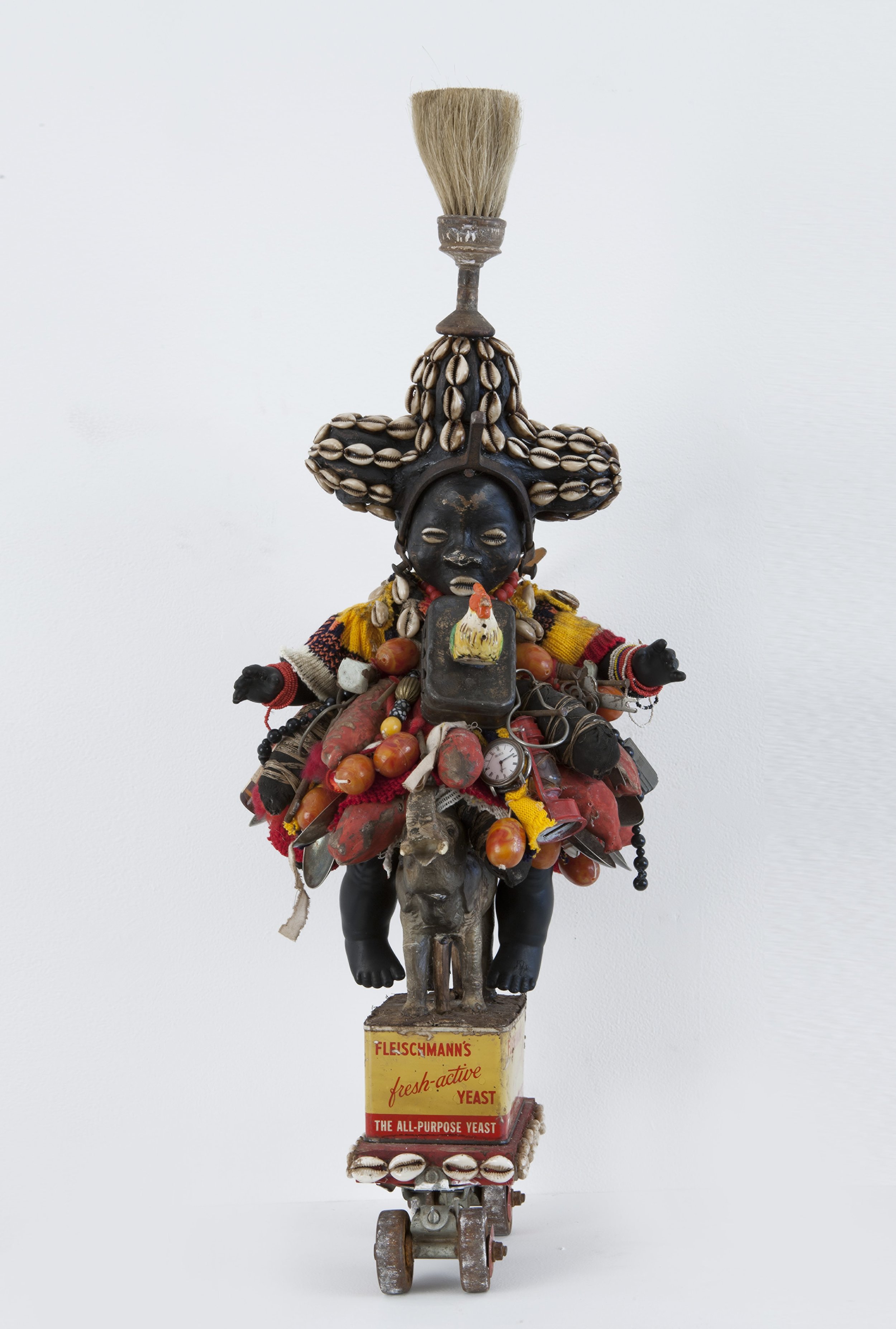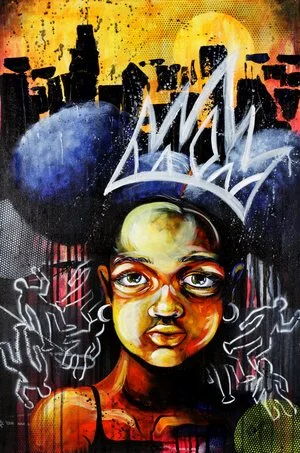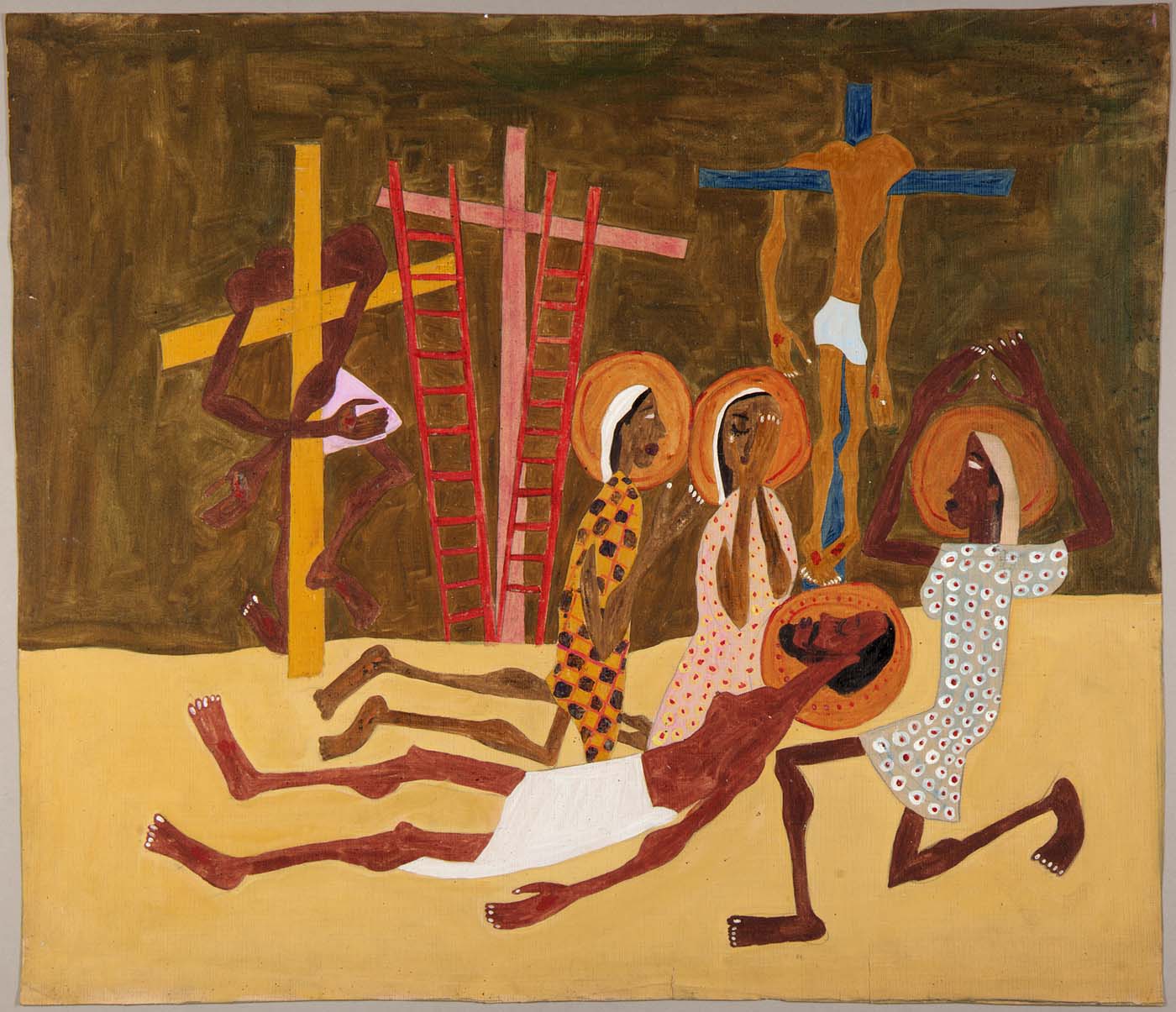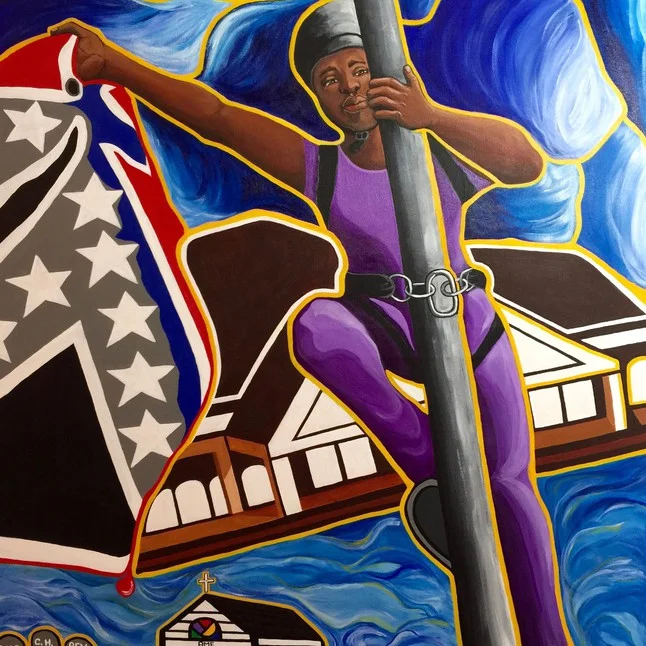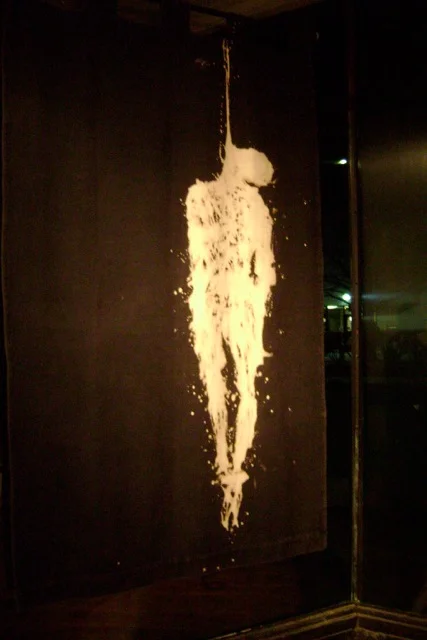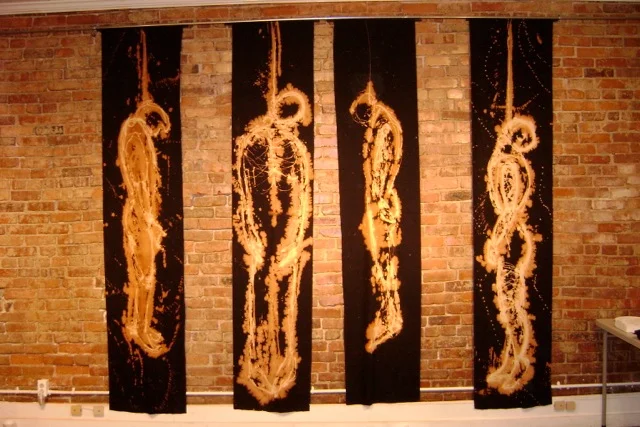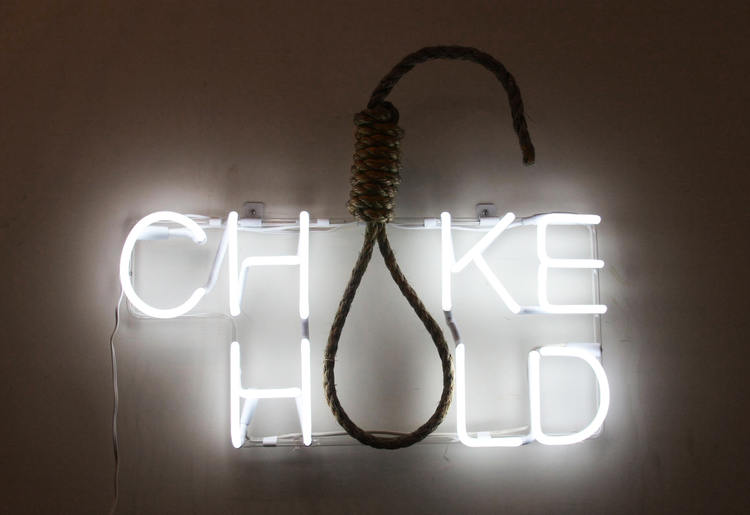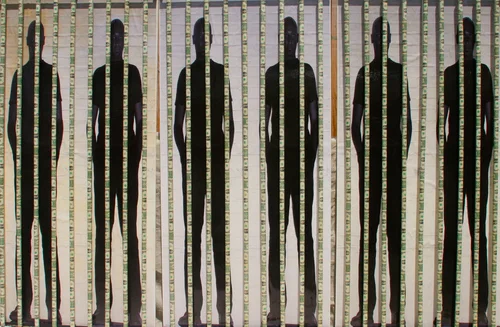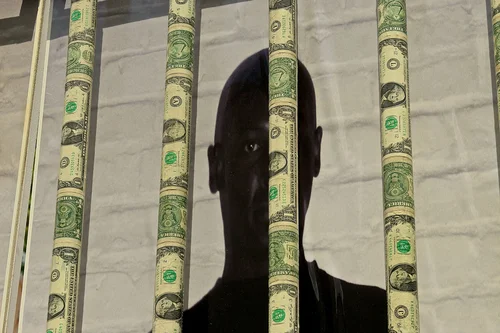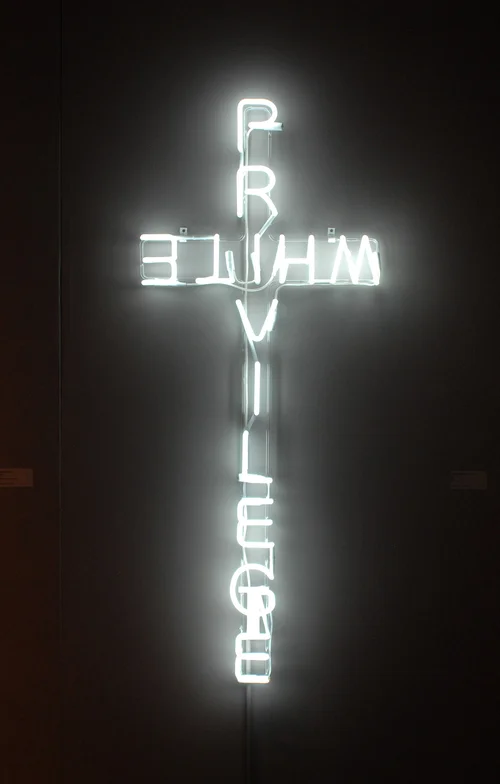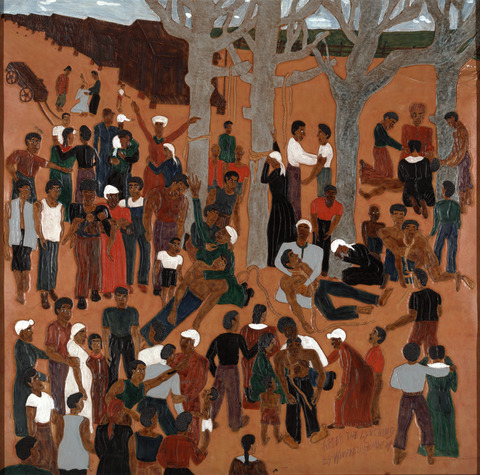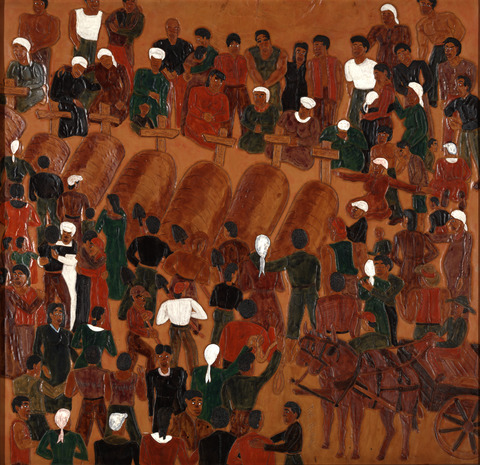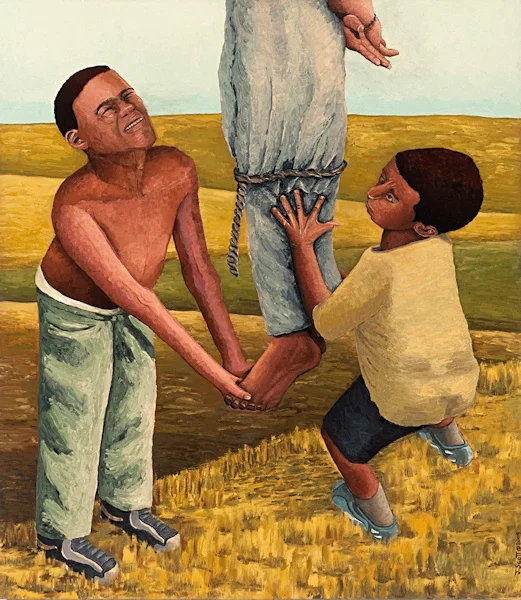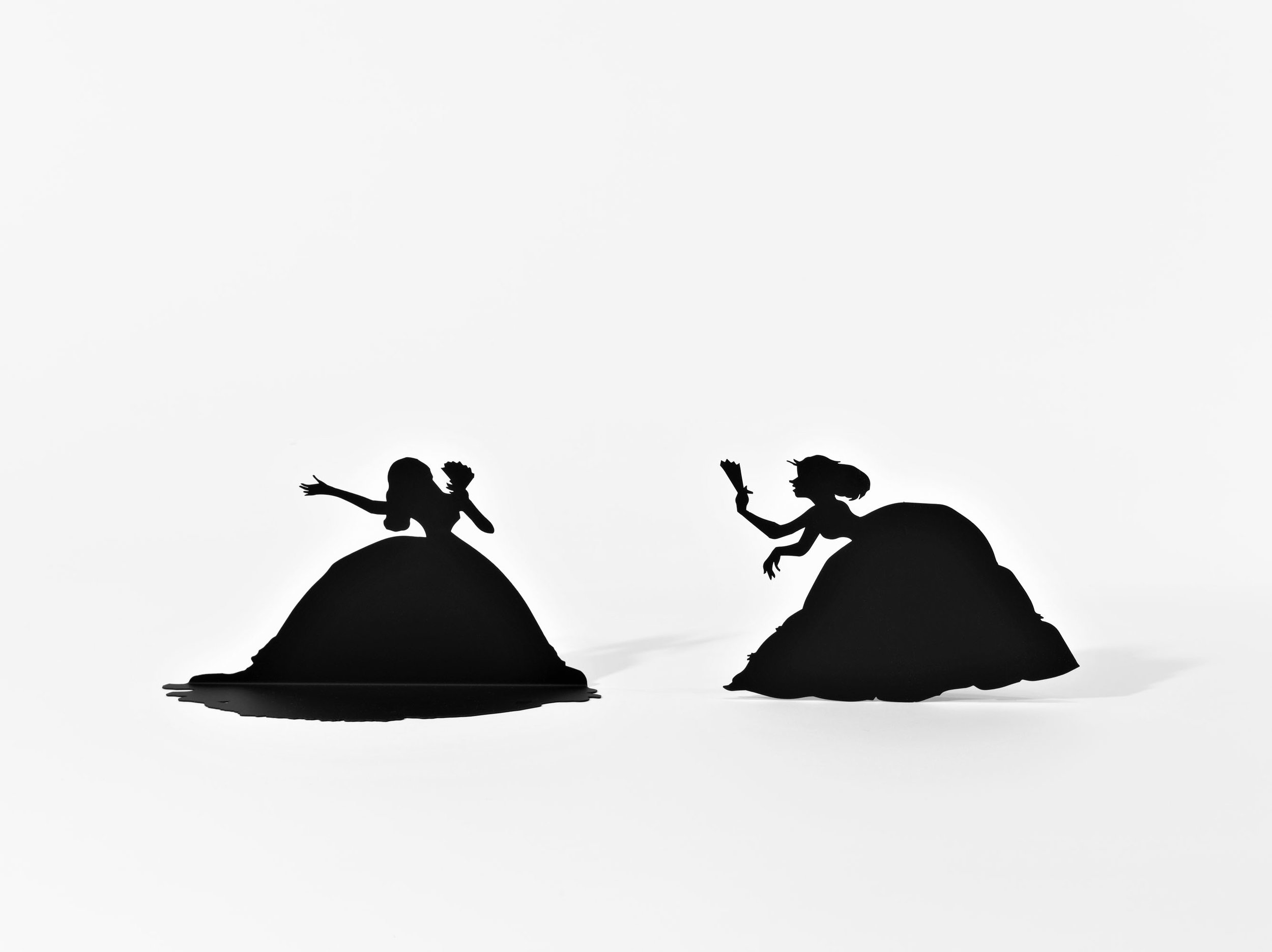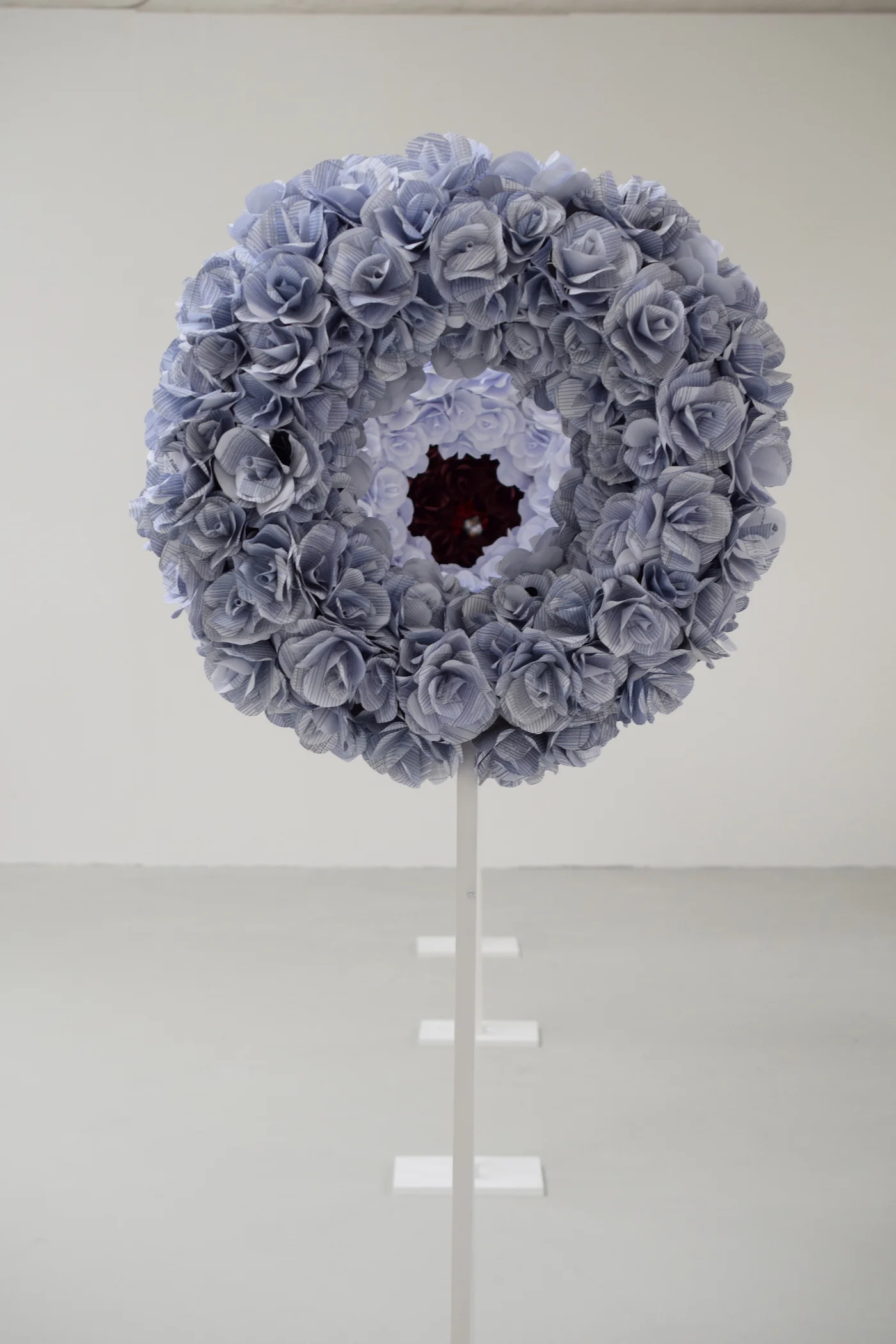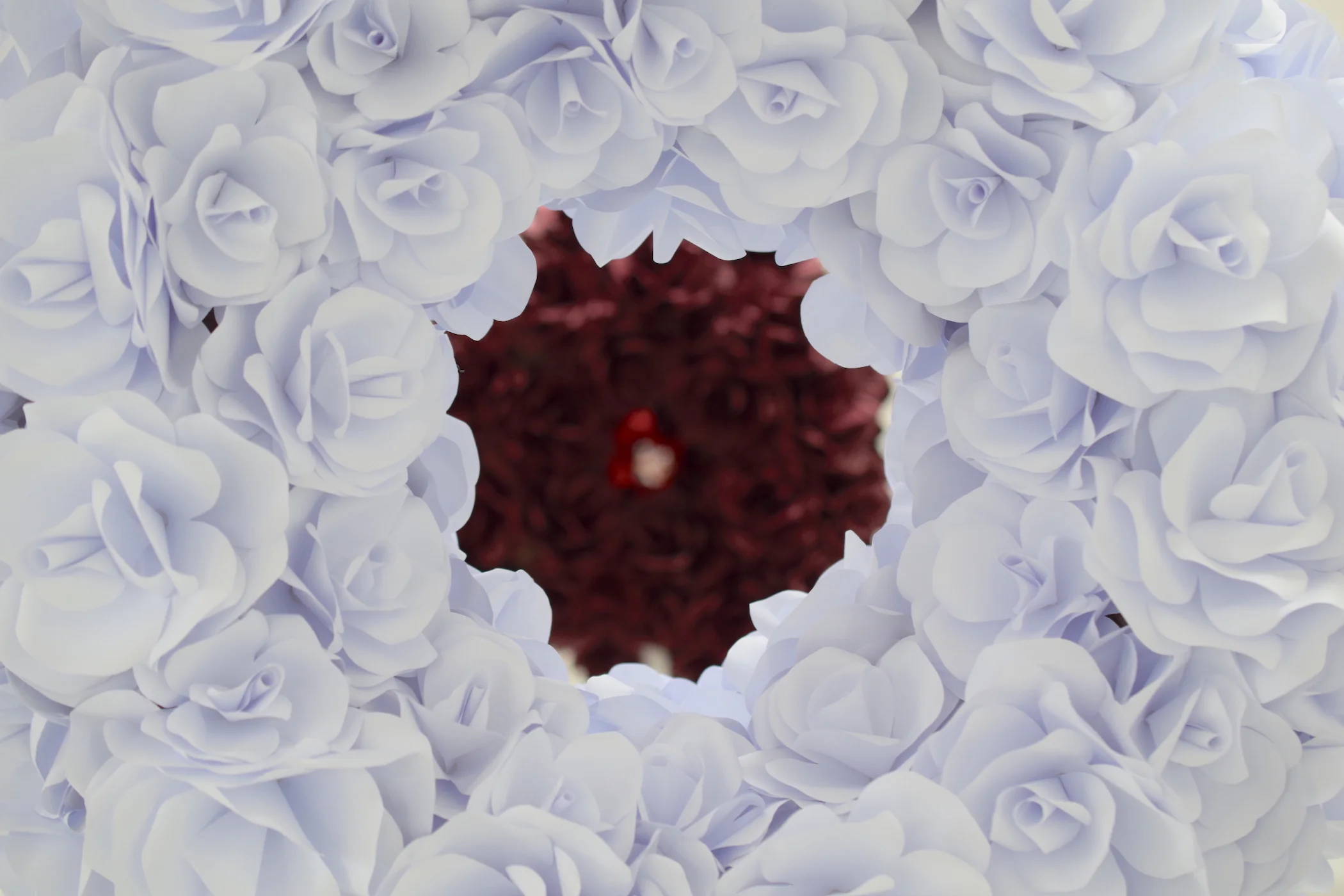10KSouls: Artists
B-Mor7
B-Mor7 (Blessed Movement & Original Rhymes Divine): artist, activist/organizer, educator, mentor, and inspiration; dedicated to Hip Hop Culture and beyond.
The Human Equation: Unarmed inFraction (Fraction from the Latin fractus meaning broken and infraction as a violation or infringement of the law) is a multi-media examination of hate crime in America with a focus on lynching and extra judicial killings by individuals and police. The title is a play on words that uses math fractions and equations to break down the infractions perpetrated by vigilantes on a continuum from slavery to mass incarceration.
On the 10KSouls playlist: #SayHerName and Red Record 2, a rap about Ida B. Wells.
Red Record II: In Memoriam © B-Mor7, used with permission of the artist.
Target Practice © B-Mor7, used with permission of the artist.
Howard barry
I have always been an artistic/creative person as far back as I can remember. Drawing and Painting came easy for me, but after I acquired a Traumatic Brain Injury during my time in service, I lost those abilities. I thought my days of creating were over, however over the years I have managed to relearn a few things and have returned to the creative path. Art has become my therapy and my release...it helps me make sense of things. I currently hold an AAS in Graphic Design and am pursuing my Bachelor's Degree in Fine Art. I love working with just about every kind of media, but my current obsession is taking both traditional and digital mediums and "smashing" them together to create something unique.
sanford biggers
Sanford Biggers is a Harlem-based interdisciplinary artist who works in film/video, installation, sculpture, music, and performance.
Blossom, 2007
Steel, Zoopoxy, silk leaves, piano with MIDI system, piano bench, dirt
144 x 216 x 180 inches 365.8 x 548.6 x 457.2 cm
Courtesy of the artist and Marianne Boesky Gallery, New York and Aspen. ©Sanford Biggers.
Laocoön, 2016
Vinyl and electric air pump
140 x 348 x 240 inches 355.6 x 883.9 x 609.6 cm
Courtesy of the artist and Marianne Boesky Gallery, New York and Aspen. ©Sanford Biggers.
renee billingslea
Renee Billingslea creates art that addresses issues of race and injustice in the United States. She teaches photography at Santa Clara University.
Her exhibit, "The Fabric of Race: Racial Violence and Lynching in America," includes hundreds of white dress shirts burned and stained, each with a hand-embroidered identity tag which hang from a gallery wall honoring forgotten victims. On a shelf sits an assortment of rusty canning jars, filled with disturbing images, body parts, teeth and ashes, objects that represent souvenirs collected by people who attended the thousands of lynchings of primarily black men, women and children in the U.S. The work also addresses the perpetrators and lynch mobs. A line of hand-made hats include text stating what each man experienced or the role he played as a mob member.
rod brown
For more than 30 years, I have been painting professionally, telling the African American story from Goree Island to the American south. My artwork has been recognized internationally in print, books, film, sitcoms, and exhibits.
Bunbury Creative - Greg Bunbury
I’m a graphic designer and multidisciplinary creative based in North London, working as Bunbury Creative since 2010. I hold a BA (Hons) in Design Studies, and have worked in a mix of in-house and agency roles for over a decade, most recently as a marketing agency Head Of Creative. I’ve provided graphic design and art direction services for agencies and businesses in entertainment, b2b, telecoms, corporate, recruitment, education, and government. I tend to specialise in projects for music and film.
I work through Bunbury Creative Ltd and also work independently as an illustrator and poster artist, on commissioned and self-initiated projects in the UK and the US.
Eric Garner Tribute Poster © Bunbury Creative UK, used with permission.
Patrick Campbell
Patrick Campbell was born in Maryland, raised in Washington DC. On October 12, 2004, Patrick suffered a stroke that left him paralyzed on his right side. As an active teen who played 4 different sports and danced, this was a hard pill to swallow. Most of all, he had been right-handed and the stroke rendered him unable to draw, or for that matter, write.
By the time he was discharged from the hospital, two months after his stroke, he could draw with his left hand just as well as, if not better than, his right. He is no longer wheelchair-bound.
In 2014, Patrick graduated from California College of the Arts with a B.F.A. in Illustration.
He created "The New Age of Slavery" after the not-guilty verdict for the murderer of Eric Garner. It now hangs in the National Museum of African American History and Culture.
New Age of Slavery, 2014. Watercolor on paper. Collection of the Smithsonian National Museum of African American History and Culture. © Patrick Campbell Art and Illustration.
Max King Cap
Max King Cap, former firefighter and advertising copywriter, is an artist whose work in various media has been seen in numerous galleries and museums in the US and Europe. He is also an educator who has, in twenty years in academia, taught most recently at Pitzer College. After earning his MFA from the University of Chicago he taught in the architecture department of the Illinois Institute of Technology and was an artist-in-residence at the Kunst Akademie Karlsruhe in Germany. He received his doctorate from the University of Southern California.
Memories - A family portrait and history lesson that references the artist's family. His maternal grandfather, Earl, who was born in Wyoming and worked as a cowboy. His great uncle, James, was lynched in Georgia after being accused of cheating at cards. The lasso, on one end, alludes to the creation myth of the United States—taming the wild west—and the noose on the other end illustrates the racial oppression that built its wealth and privilege.
© Max King Cap
Used with permission of the artist.
We Own The Night - A recreation of the crime scene where four NYPD officers murdered Amadou Diallo, firing 41 bullets at the unarmed man who was just standing in front of his apartment building.
© Max King Cap
Used with permission of the artist.
loring cornish
I'm not a trained artist; they call me a visionary, an "outsider" artist. My work comes out of my relationship with God. While I worship, I create, and while I create, I worship God.
I was drawn to mosaics almost accidentally. While repairing the termite-damaged floor of a house I was renting, I was given some broken tiles. I glued them to the floor to cover the holes. One thing led to another, and pretty soon the floor and walls were covered with materials. I covered one whole wall with pennies.
When I started, I was gathering and collecting materials with a shopping cart. I took junk and trash off the streets and alleys and turned it into art. Now some of that junk and trash is hanging in museums. I still find my materials just about anywhere, making art out of what the city has to offer. I pretty much use what ever is in season.
The materials I use have no particular meaning. I don't spend much time thinking about the reason behind the work. I get an idea and I proceed. I work with whatever I have on hand at that moment. I don't search for colors or materials, I use what finds me. I feel this keeps the process of making art as simple as possible, leaving me more time to create.
When I first started doing art everything had a religious meaning behind it. I've since then expanded, allowing my creative process to take me wherever it wants to go, no holds barred. When something's in your heart, you can't contain it.
Sign © Loring Cornish, used with permission of the artist.
Tree Babes © Loring Cornish, used with permission of the artist.
molly crabapple
Molly Crabapple is an artist, journalist, and author of the memoir, Drawing Blood. Called "An emblem of the way art can break out of the gilded gallery" by the New Republic, she has drawn in and reported from Guantanamo Bay, Abu Dhabi's migrant labor camps, and in Syria, Lebanon, Gaza, the West Bank, and Iraqi Kurdistan. Crabapple is a contributing editor for VICE, and has written for publications including The New York Times, Paris Review, and Vanity Fair. Her work is in the permanent collection of the Museum of Modern Art.
Hands Up Don't Shoot © Molly Crabapple, used with permission of the artist.
michael dixon
Michael Dixon is an artist working primarily with oil paint. He was born in San Diego, California, and received his MFA from the University of Colorado at Boulder. Dixon is currently an Associate Professor at Albion College, a four-year liberal arts school in Michigan. His work has been shown both nationally and internationally at museums, universities, art centers, alternative spaces, and galleries. Dixon explores the personal, societal, and aesthetic struggles of belonging to both "white" and "black" racial and cultural identities, yet simultaneously belonging fully to neither. The works of artists such as Robert Colescott, Beverly McIver, Michael Ray Charles, Glenn Ligon, and Kerry James Marshall have informed his work.
Settling Down Is Hard To Do When You Are Fading Into Nothing © Michael Dixon, used with permission of the artist.
mark dukes
Mark Dukes discovered Byzantine styled icons in his twenties after leaving art school to go on a spiritual quest. He investigated a calling to be a monk in an Eastern Orthodox monastery in Texas where he saw Byzantine styled icons for the first time. He fell in love with the form and continued to 'write' icons even after he decided that he didn't have a calling to be a monk and had left the monastery. He has been blessed to have worked on the iconographic programs of two nationally recognized churches- St. Gregory of Nysa Episcopal Church and the St. John Coltrane African Orthodox Church- both of San Francisco. Through these projects, his work has been featured in national magazines such as Vibe, The Wall Street Journal and The New York Times Magazine.
Ferguson Mother of God: Our Lady against all Gun Violence, 2015
Acrylic Collage painting
© Mark Dukes, used with permission of the artist.
vanessa german
Vanessa German is a multi-disciplinary artist based in Pittsburgh, Pennsylvania. She is the founder of Love Front Porch and the ARThouse, a community arts initiative for the children of her historic Homewood neighborhood. Her work is in private and public collections including Crystal Bridges Museum of American Art, The Progressive Art Collection, David C. Driskell Center for the Study of the Visual Arts and Culture of African Americans and the African Diaspora, Snite Museum of Art, among others. German’s fine art work has been exhibited widely, most recently at Spelman College Museum of Fine Art, Atlanta, GA; the Wadsworth Atheneum Museum of Art, Hartford, CT; the Studio Museum, Harlem, NY; the Ringling Museum of Art, Sarasota, FL; and in the traveling exhibition State of The Art: Discovering American Art Now, which originated at the Crystal Bridges Museum of American Art, Bentonville, AR. Her work has been featured on CBS Sunday Morning, NPR’s All Things Considered and in The Huffington Post, O Magazine and Essence Magazine. She is the recipient of the 2015 Louis Comfort Tiffany Foundation Grant.
aramis o. hamer
I create my paintings using acrylic and, sometimes, spray paint. I made the decision to pursue my art career after leaving my hometown in Chicago and moving to Washington. When I'm not painting, I work part time as a registered nurse at a local community hospital. Interactions with my patients remind me to be grateful for my health and happiness.
When I think of my artwork, I’m reminded of a colorful world that can only be found in dreams. The basic themes found in my work are strong color contrasts, exaggerated subject matter and drip techniques where I try to stretch the boundaries of surrealism. Music is definitely one of my main inspirations. Songs are like stories and while listening to the lyrics, an image forms in my mind inspiring the next piece. Utilizing house hold tools, such as a grout spreader, creates texture that mimics sound waves in music. I love to incorporate spray paint related to my admiration of street art. Integrating imagery of my people and urban landscapes reflects the environment in which I was raised.
Not Fit For a Princess, © Aramis O. Hamer, used with permission of the artist.
Theodore A. Harris
Theodore A. Harris was born in 1966 in New York City, NY and raised in Philadelphia, PA, where his art practice is based. Harris is a collagist, poet, and has co-authored books with Amiri Baraka Our Flesh of Flames (Anvil Arts Press) and Malcolm X as Ideology (Lebow Books), with Fred Moten i ran from it and was still in it (Cusp Books),and TRIPTYCH: Text by Amiri Baraka and Jack Hirschman (Caza De Poeisa).
1999, Remember Eric Smith, © Theodore A. Harris, used with permission of the artist.
zeal Harris
Currently, I'm making whimsical, colorful, narrative paintings that can be described as urban vernacular, folky, political cartoons. My materials are experimental and I use fabric, panels, paper, canvas. digital processing, and waterbased and oil-based mediums.
My work is about experimental storytelling. It’s about collecting, telling, and revealing characters on journeys through space and time. Whether the work is a micro-narrative or an epic, linear or non-linear, or whether it is a recognizable or an obscure narrative, the characters in my paintings are vehicles whose stories serve to complexify grandnarratives of black lives. Always, I am seeking new angles to prompt fresh dialogue about sociocultural issues. Race, class, gender, culture, love, war, and the mystical coexist in this world. Oral culture is privileged.
While my work is unabashedly political, it is also sentimental, and critical. I am most pleased when my work prompts fresh dialogues through multiple academic discourses and diverse audiences.
Like many artists, I am liminal and I'm a hybrid. My influences are eclectic and span the history of artmaking from around the world and from the beginning of time. My influences and references can vary from artwork to artwork.
Having said the aforementioned allows me to reveal a too short cross section of influences that includes; Nellie Mae Rowe, Jacob Lawrence, Xiomara de Oliver, Florine Stettheimer, Eduoard Duval Carrie, Zora Neale Hurston, Carmen Lomas Garza, Haitian Vodou flags, Mexican Ex-voto paintings, Asian scroll paintings, Persian miniatures, graphic novels, and an array of narrative textiles and contemporary illustrations.
With my work, I am committed to documenting the breadth and depth one African-American woman’s representational imagination and her concerns. Leaving trace— signifyin’ this life to others is the benediction.
American Sculpture Garden, 2004, 10 x 12 inches, acrylic on canvas
© Zeal Harris, used with permission of the artist.
Louis Head
Mr. Louis Head holding a cardboard sign on social media, broadcasting the execution of his stepson, Michael Brown, Jr., is what led many of us to Ferguson, Missouri. Photo used with permission of Mr. Head.
Mr. Louis Head: Ferguson Police Just Executed My Unarmed Son, Sign, 2014, used with permission of Mr. Head.
william h. johnson
(1901-1970)
William H. Johnson's artistic career ended abruptly in 1947 when he was confined to Central Islip State Hospital on Long Island for a psychiatric disorder. Despondent and withdrawn, he never left the hospital or painted again. In the years before his hospitalization, he chronicled the history of African Americans.
He placed his own face on the lynched cruciform figure of Nat Turner in a multi-layered image of martyrdom that illustrates the personal reality of racism.
adrienne la faye
Painter, Illustrator and Author Ninety percent of my creativity is born out of who I am, how I'm not accepted and how the world perceives me. Yet, a small innate portion of my creativity was birthed in innocence, which I instinctively protect from the harshness of our society. As a social justice advocate and activist, my paintings often depict the lives of people who have been disenfranchised and marginalized. My work philosophically explores themes of racism, homophobia, and gender bias, all based on my truth.
Bree Newsome and the South Carolina Nine © Adrienne La Faye, used with permission of the artist.
Prison Project I © Jill LIttlewood, used with permission of the artist.
Prison Project II © Jill LIttlewood, used with permission of the artist.
gwendolyn magee
(1940-2011)
1995 was the year Gwendolyn Magee first began to consider her work as art. Since then, it has been featured in many books and publications. Her solo exhibit, "A Journey of the Spirit: The Art of Gwendolyn A. Magee" toured for two years to ten venues accompanied by a monograph of the same title.
Gwen's work is found in the permanent collections of the Smithsonian American Art Museum and the Mississippi Museum of Art and has been exhibited internationally. It is archived at the National Museum of Women in the Arts, and in 2006 she was named as an "Honored Artist" by its Mississippi State Committee. In 2005 she was awarded an Artist Fellowship Grant by the Mississippi Arts Commission and selected in 2004 to represent the state on SouthernArtistry.com, a showcase "…spotlighting the diversity and achievements of outstanding artists who live and work in the South." Gwen was recognized by the Mississippi Institute of Arts and Letters as Visual Artist of the Year in 2003.
Along with her husband, Gwen had two daughters, a son-in-law and two grandsons. Originally from High Point, North Carolina, she was a resident of Jackson, Mississippi from 1972 until her death in 2011.
Ti-Rock moore
Who should speak when the subject of art is racism? Is it the subject/victim only, when/if he or she is still able to speak? Or is it the perpetrator, in the zero sum game, victor-takes-the-spoils collapsing American psyche? With racism, you have two actors, two groups, a protagonist and an antagonist, a perpetrator and a victim, an Us and a Them, often, though not always, black and white. In this instance, whose voice has the authority to speak, indeed, to critique, the juggernaut of racism in the United States, that groaning, bloated, yet somehow newly recharged monster that so many people had naïvely relegated to the past? Who is responsible for her group; who is implicated by her privilege, and who by her debasement? And will the message necessarily be different if it comes from either messenger?
I acknowledge my white privilege as a direct remnant of slavery, the result of atrocities committed against others. I explore it through my acute awareness of the unearned advantage my white skin holds. White privilege controls America’s heartbeat, and our nation’s collective loss of memory, our historical amnesia, is to blame. I examine my self and identity in a critical manner; I hold my audience and me accountable for our complicity. Indeed, it is past time for white Americans to hold accountability for and stand up to the injustices of racial oppression.
My art is an expression of my activism, constantly and consistently mining the past to disrupt the present in order to secure the future. It is loud, expressing the pain and rage of our continued collective disavowal of responsibility from the very systems we uphold. My work is rooted in a critique of white supremacy and the systemic oppression of people of color in the United States, and it is reactive to the violent, vicious, genocidal, and unapologetic way in which we differentiate between each other based on race, gender, and class.
William Henderson moore
William Henderson Moore is a painter based in the Pacific Northwest.
Readergirl Sleeping © William Henderson Moore, used with permission of the artist.
isamu noguchi
Isamu Noguchi (1904–1988) was one of the twentieth century’s most important and critically acclaimed sculptors. Through a lifetime of artistic experimentation, he created sculptures, gardens, furniture and lighting designs, ceramics, architecture, and set designs. His work, at once subtle and bold, traditional and modern, set a new standard for the reintegration of the arts.
Death (Lynched Figure), 1934. Isamu Noguchi. Monel metal, steel, wood, rope. 88 3/4 x 31 7/8 x 22 1/8 in. Collection of The Isamu Noguchi Foundation and Garden Museum, New York. © The Isamu Noguchi Foundation and Garden Museum, New York / Artist Rights Society [ARS]. Photo by Sara Wells.
Reproduction, including downloading of Isamu Noguchi works is prohibited by copyright laws and international conventions without the express written permission of Artists Rights Society (ARS), New York.
noah purifoy
Born in Snow Hill, Alabama in 1917, Noah Purifoy lived and worked most of his life in Los Angeles and Joshua Tree, California, where he died in 2004.
His earliest body of sculpture, constructed out of charred debris from the 1965 Watts rebellion, was the basis for 66 Signs of Neon, the landmark 1966 group exhibition on the Watts riots that traveled throughout the country. He was a founding director of the Watts Towers Art Center.
In the late 80s, Purifoy moved his practice out to the Mojave desert. He lived for the last 15 years of his life creating ten acres full of large-scale sculpture on the desert floor. Constructed entirely from junked materials, this otherworldly environment is one of California’s great art historical wonders.
Hanging Tree, 1990. 52 x 40 in. © Noah Purifoy Foundation, courtesy of Noah Purifoy Foundation.
winfred rembert
Winfred Rembert is an African American artist who hand-tools and paints on leather canvases. Rembert grew up in Cuthbert, Georgia, where he spent much of his childhood laboring in the cotton fields. He was arrested during a 1960s civil rights march and described himself as the only person to survive a lynching.
In 1964, Rembert participated in a demonstration, tussled with a sheriff, then escaped by jumping into a car with the keys inside. Four hours later, he was caught, thrown in the trunk of a car and brought to a site where he saw three ropes hanging. The following account is from the New Haven Register:
What did he think when he heard 27 years?
"I thought I was dreaming. I couldn't believe he was actually giving me 27 years, but it was true. I looked around the courtroom, and there was no one else there except the judge and the sheriff and what looked like a few lawyers, but no one there for me."
synthia saint james
Synthia Saint James is a self-taught visual artist, award-winning author and/or illustrator of 17 children’s books, an art marketing book, three poetry books, a book of affirmations, and a cookbook. She is most celebrated for designing the first Kwanzaa Stamp for the United States Postal Service in 1997, for which she received a History Maker Award, and for the international cover art for Terry McMillan’s book Waiting to Exhale.
Souvenance: The Sacred Mapou. Oil & Acrylic on Canvas, 36x30x1.5. © Synthia Saint James, used with permission of the artist.
dread scott
Dread Scott makes revolutionary art to propel history forward. He first received national attention in 1989 when his art became the center of controversy over its use of the American flag while he was a student at the School of the Art Institute of Chicago. President G.H.W. Bush called his art “disgraceful” and the entire US Senate denounced this work and outlawed it when they passed legislation to “protect the flag.”
He has been written about in The New York Times, Art In America, Sculpture Magazine, ArtNews, ArtForum, Art21 Magazine, Time, The London Guardian and several other newspapers, magazines and books. He has appeared on numerous local and national TV and radio shows including Oprah, The Today Show, and CBS This Morning speaking about his work and the controversy surrounding it.
He works in a range of media including performance, photography, installation, screen-printing and video. His works can be hard-edged and poignant. Dread plays with fire—metaphorically and sometimes literally—as when he burned $171 on Wall Street and encouraged those with money to burn to add theirs to the pyre.
"I work in a range of media: performance, installation, video, photography, printmaking and painting. The thread that connects my work is an engagement with sharp social questions confronting humanity and a desire to push formal and conceptual boundaries as part of contributing to artistic development. My projects are presented in venues ranging from major museum galleries to street corners. Sometimes work is presented to an unexpecting audience. I bring contemporary art to a broader public and the audience is often an active element of the artwork."
A Man Was Lynched By Police Yesterday © Dread Scott, Creative Commons CC BY-NC-SA 4.0.
Blue Wall of Violence © Dread Scott, Creative Commons CC BY-NC-SA 4.0.
jennifer scott
As a professional artist, art educator, and community builder I work with diverse ethnic/indigenous communities which inform the content of my artwork. I use art and art education to build community and improve the lives of individuals within those diverse communities.
This series of paintings and collages, Stories Behind the Postcards/Jim Crow, respond to lynching postcards that were mailed around the country during the Jim Crow era as souvenirs. Thousands upon thousands of African Americans were lynched between the 1880s and the Second World War. Over the years, I have thought about what I did not see in the postcards, primarily the family members left behind to take down the victim, to mourn and bury their remains if there was enough left to bury.
The Impossible © Jennifer Scott, used with permission of the artist.
My Son, My Grandson © Jennifer Scott, used with permission of the artist.
Three Generations © Jennifer Scott, used with permission of the artist.
melissa pope scott
I am a mother, gardener, partner, cook, writer, painter, reader, free thinker, friend to Earth.
Ashantilly Hill Slave Dwelling © Melissa Pope Scott
john sims
John Sims, a Detroit native, is a multi-media artist, writer and producer, creating projects spanning the areas of mathematics, art, text, performance and political-media activism. His main projects are informed by the vocabulary of mathematical structure, the politics of sacred symbols and poetry as ally to the visual arts. The works have ranged from hanging the Confederate flag in Gettysburg (2004), to making a system of MathArt quilts with Amish quilters (2008) to the current planning of turning NYC into a clock, to organizing a 13-state burial of Confederate flag on Memorial Day 2015. He is currently completing, Recoloration Proclamation, 16 year multi-media project featuring: an exhibition of recolored and hanging Confederate flags, a multi-state flag funerals, a play, a documentary film and a music project featuring 13 black versions of the song "Dixie." He has lectured and exhibited both nationally and internationally and his work has been featured in Art in America, Sculpture, Transition, FiberArts, Science News, CNN, NBC News, New York Times, USA Today, The Guardian, Wall Street Journal, Washington Post, The Root, The Rumpus, The Huffington Post, The Grio, and the science journal Nature.
The Proper Way To Hang A Confederate Flag © John Sims, used with permission of the artist.
LaShawnda Crowe Storm
If life were a photo, then my artwork would be its negative, seeking to explore those aspects in our society that have been ignored or forgotten such as history, lynching, misogyny, slavery and suicide.
By printing these forgotten negatives, I give voice to the marginalized people and disregarded aspects of our society.
For me art is my form of social work and I use it to open doorways to community dialog, which is the first step to healing, which in itself leads to wider social change.
Although I draw inspiration from traditional African spiritual practices, folklore, current and historical events, my work is ultimately about community, healing and memory.
Names of the Lynched Wallpaper © LaShawnda Crowe Storm, used with permission of the artist.
jason decaires taylor
Jason deCaires Taylor is a sculptor, environmentalist and professional underwater photographer. Born in 1974 to an English father and Guyanese mother, Taylor graduated from the London Institute of Arts in 1998 with a BA Honours in Sculpture.
His permanent site-specific works span several continents and predominately explore submerged and tidal marine environments. His multi-disciplinarily sculptural works explore modern themes of conservation and environmental activism; Over the past 10 years Taylor he has created several large-scale underwater “Museums” and “Sculpture Parks”, with collections of over 850 life-size public works.
A prolific sculptor, he became the first of a new generation of artists to shift the concepts of the Land art movement into the realm of the marine environment. He gained international notoriety in 2006 with the creation of the world’s first underwater sculpture park, situated off the west coast of Grenada in the West Indies. Now listed as one of the Top 25 Wonders of the World by National Geographic the park was instrumental in the government declaring the site a National Marine Protected Area.
Vicissitudes, Granada © Jason deCaires Taylor, used with permission of the artist.
Vicissitudes, Granada, Clean © Jason deCaires Taylor, used with permission of the artist.
Stacey Torres
PLEASE, SAY HER NAME, is a painting of an African American Woman sitting in front of a quilt bearing the names of Black Women martyrs who unjustly lost their lives in the 21st Century. She is holding a colorful quilt bearing no names - which is her hope for the future.
This painting was part of the 2017 Hoosier Women in Art Exhibition: Politics & Protest, at the Garfield Park Arts Center, Indianapolis, Indiana, and sponsored by the Indy Parks Department.
Some of my artwork has been featured on CBS' "Criminal Minds," Season 10.
Please, Say Her Name! 2017. Acrylic w/India Ink on a 30 x 30" wood panel. © Stacey Torres, used with permission of the artist.
kara walker
American painter.
Nafis M. White
Nafis White works in sculpture, photography, video, collage, sound and performance exploring issues of identity, race, inequality, politics and landscape, using personal narratives to facilitate and build conversations with the viewer. Her approach is one that is heavily influenced by conceptualism as well as aesthetics and climate, both political and social, with much of her work currently centered around the New Civil Rights Movement in the United States. Nafis employs many different strategies in the way that she visualizes and then builds work, utilizing a multidisciplinary approach to her art making. White received her BFA in Sculpture with a Concentration in Art History from the Rhode Island School of Design before studying for her MFA at Goldsmiths University of London.
Nafis currently lives and works in London, England.
Trish Williams
Fiber artist.
I bring together the rhythm of hand-dyed, painted and commercially-made fabrics with the syncopated lines of my quilting to tell stories about the African Diaspora and my community. While my textiles are steeped in the tradition of the story quilt, cloth-based narratives constructed frequently from scraps of clothing and other familiar fabrics to record history at a particular time and place, they are intended to be viewed on the wall rather than to dress a bed. My tales are for all to see and know, rather than for just an intimate few. I challenge the status quo, refusing to accept the stereotypes forced upon me by society. Instead, I question the very nature of these stereotypes using familiar forms and processes to hold the viewer’s attention.
I created Miss Laura Fruit Tree in honor of Laura Nelson once LaShawnda (Crowe Storm) introduced me to her and her family. Miss Laura Fruit Tree made an appearance in Southside With You, the film about Barack and Michelle Obama's first date.
Miss Laura Fruit Tree © Trish Williams, used with permission of the artist.
carletta carrington wilson
Carletta Carrington Wilson's mixed-media collages have been described as "decorative with a message." Textiles, found objects, beads and paper revolve around a central iconic image. These elements serve the purpose of enhancing, highlighting, inferring and interrogating the image and the ideas it presents and portrays.
abduction, Mixed-media assemblage
© Carletta Carrington Wilson, used with permission of the artist.
wonderroot center for arts and social change
WonderRoot is an arts organization that works to improve the cultural and social landscape of Atlanta through creative initiatives and community partnerships. The anchor of our organization is our Arts Center - a full-service facility that supports artists, offers public programming and brings diverse voices together to envision and activate a stronger Atlanta.
We Gonna Be Alright © WonderRoot Center for Arts and Social Change, used with permission.
Alisha B. Wormsley
I am an interdisciplinary artist. My work is about collective memory and the synchronicity of time periods. I recognize past, present and future happening simultaneously.
I use photography, video, sculpture, and sound to deconstruct accepted realities in order to recreate new conceptual mythologies. By layering methods of science fiction, collage theory, and folklore I reconstruct stories, examining themes of gender, class, race and time.
My work has led me throughout the world; collecting stories, researching cultures, participating in myth and ceremony. I collaborate with artists, communities, students, landscapes and history.
I am interested in the human experience. I work to tear down boundaries of forgetfulness. To encourage us to remember one beginning and one end. I examine the connections between these two points. The connections I discover inspire an infusion of both cross-cultural phenomena and popular culture, new fables and new science fictions. Within those discoveries I create other realities, magnifying the lens to look closely at the intentions of realities. This process is present in all my work.
Totems, tarot, bottle trees, mantras, religious texts, mysticism, popular culture, cultural shame, urban legends, childhood memorabilia, funeral rites, folk music (from chanting to hiphop), creation stories and symbols are all my tools to expand on, to alter, to make timeless.
From the series, There Are Black People In The Future, © Alisha B. Wormsley, used with permission of the artist.


